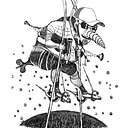by Vas Mylko, Roman Bilusiak
We are working on the flowers. “Flower” is a new topology of the route that Curiosio will be creating for travelers. People are telling us that it’s more important to do fewer check-ins rather than visiting more attractions & POIs in the area. Especially the travelers with kids are reporting the preference of staying at the same location and exploring its environs. This means “flowers”.
The road from your home to your destination and back is a “stem”. The daily programmes are the “petals”. Multiple petals within the area of interest are a “flower”. Your destination is the center of the flower.
“Flower” Specifics
Original ruminations about the flowers and the buckets of flowers were revealed in Product Design in November 2020. This post is focused on the implementation of the flower topology, hopefully as Beta15. Here are design considerations:
- Destination matters much more than other [interesting] points. “Flower” type of travel is called a trip; while multi-point travel is called a journey.
- Booking/rental of the house/room at the destination is done in advance and is for 4–10 days.
- It’s convenient to stay at the same property, get used to the same property, know the convenience stores in direct proximity to the location of your stay. This is what people call “reduced friction”, “reduced hassle”.
- The coverage of the destination’s environs is reduced by the need to get back to the same bed every day. (Direct time spending to go from/to the same location every day.)
- The points on the “stem” are reluctantly ignored though travel through some of them with very brief sightseeing is appreciated.
- The administrative order is not so important as the location of the stay is becoming the “center of the Universe” and your daily drive-time defines the “size of the Universe”.
- The density of the POIs matters as daily programmes happen at relatively short distances.
Zoom In for Data
When you are returning to the same bed each day your drive-time/radius is significantly smaller, thus the area of See & Do is smaller. As you are exploring the same [small] area every day then a good density of See & Do is required in it. What’s important within 2–20 mi is different from what’s important at 50–100 mi distances. Where to take this data from?
Where is the data? Here comes OpenStreetMap. “OpenStreetMap aka OSM is a collaborative project to create a free editable map of the world. The geodata underlying the map is considered the primary output of the project. The creation and growth of OSM has been motivated by restrictions on use or availability of map data across much of the world, and the advent of inexpensive portable satellite navigation devices.” Wikipedia.
OSM contains massive amounts of data. It is no more about the streets only. It literary contains every building of every city and, in some cases, the level of details goes down to each tree on the street (all trees on Freedom Avenue in Lviv, Ukraine). Good that we got sufficient quantity and density of restaurants, small breweries, wineries, cheese factories, farms, etc.
Knowledge Graph with OSM
We are piloting the OSMed KG in Ukraine. During the integration of OSM points and places into our Knowledge Graph, we learned some painful lessons. OSM contains a lot of errors: wrong names, wrong coordinates, wrong links to Wikipedia, wrong tags (e.g. a small cafe with questioned quality of service tagged to look like a restaurant; or tourist attraction tag is set to a rusty sign with the city name on it). In general, OSM contains a lot of noise that has to be classified and filtered before we can use it properly.
There are not so many English Wikipedia pages for the points and places for Ukraine. Using non-English Wikipedia pages (or directly Wikidata) doesn’t solve the problem as there is nothing to open when the user clicks on such point/place for the details. We are using the Google approach to organizing the information, by knowing everything about everything [for road travel] and linking to the originals.
Below are some OSM data density testing screenshots from the Lab. OSM places and POIs will be combined with the places and POIs from Wikipedia and Atlas Obscura in the knowledge graph.
We are going to go down [almost] to geo coordinates and open Google Search or Google Maps for those locations. All points and places that have English Wikipedia or Atlas Obscura will continue to be opened on those respected websites, while details about the others will be pulled on behalf of the user request from Google on demand. Opening such points or places on the OSM website seems neither informative nor practical.
Release Schedule
First, we will release Curious Ukraine, to ensure our Ingeenee optimizer works perfectly over the OSMed Knowledge Graph. This is planned for the end of July 2021.
Then we will release Beta15 codenamed “Flowers”. This may take another month. You will be able to plan interesting “flower” trips, with cool See & Do at the destination and its environs.
